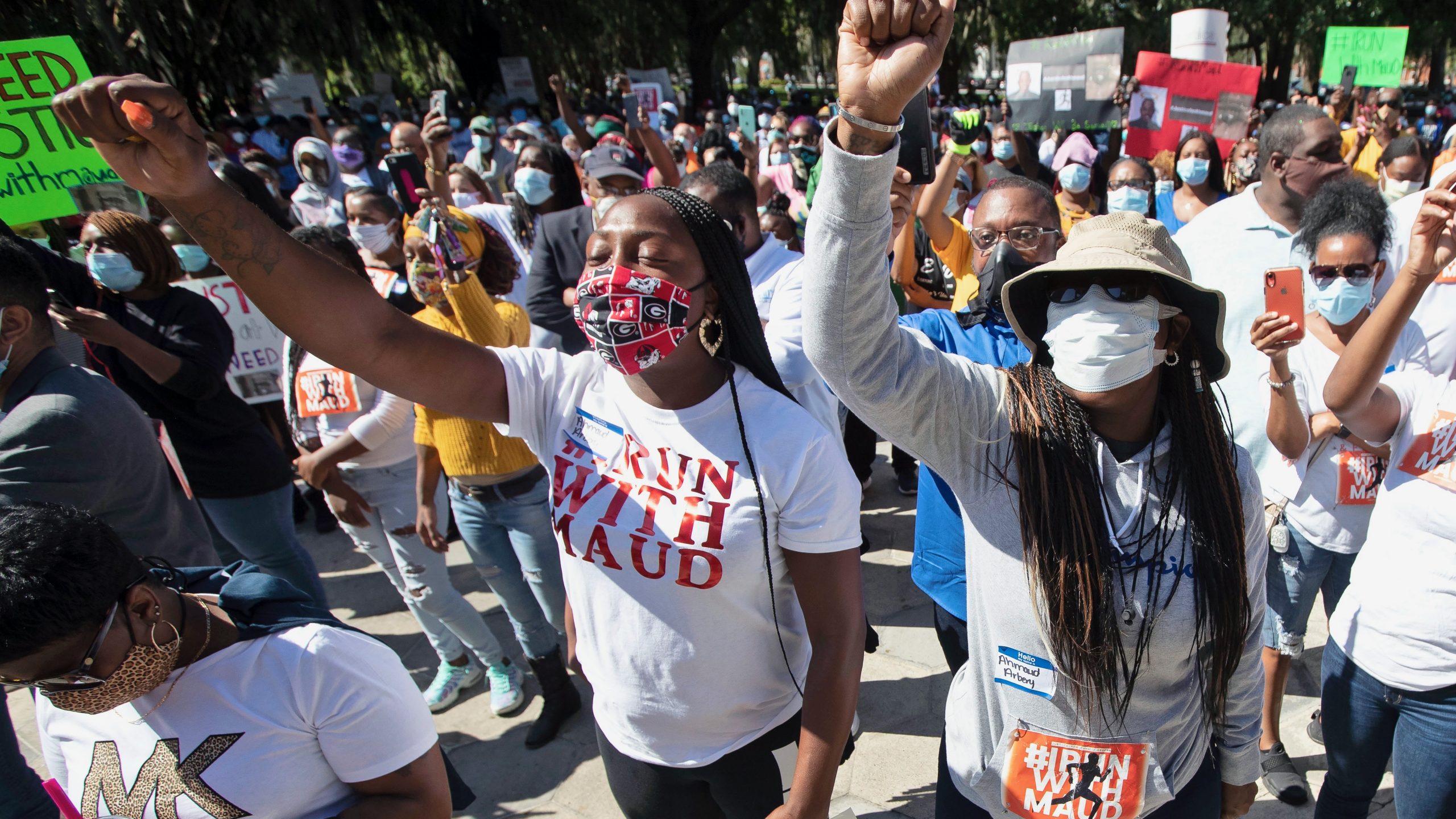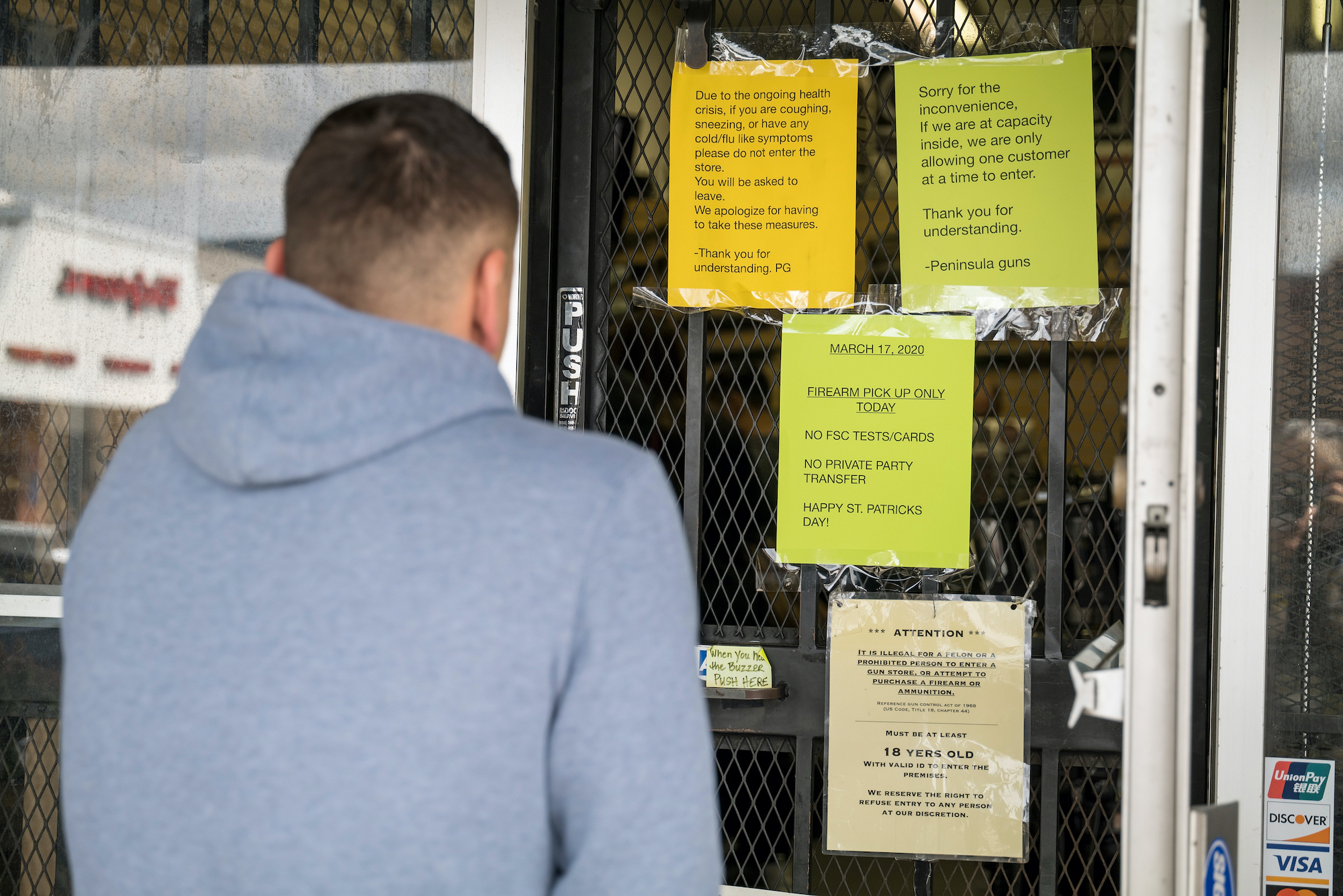Video of Mark and Patricia McCloskey, pointing guns at protesters outside their palatial home in a private community in St. Louis on June 28 has circulated widely. The incident, which briefly found its way onto President Donald Trump’s Twitter feed, prompted some to suggest that the pair, both personal injury lawyers, should be charged for what many read as an overt threat or act of intimidation.
Despite video showing Patricia McCloskey yelling angrily at protesters while pointing a handgun toward them — with her finger on the trigger — and the husband hovering nearby with a semiautomatic rifle, legal experts say it may be difficult to charge the McCloskeys with violating Missouri law. The incident is now under investigation by a local prosecutor. Whether the couple will be charged remains to be seen, and it will likely be an uphill battle for any prosecutor.
If anything is clear, the incident shows that brandishing laws are vague and often difficult to prosecute — especially in states like Missouri, where such laws are entangled within a web of other gun rights and self-defense laws.
Could the McCloskeys be charged with brandishing?
In Missouri, a patchwork of laws comes together to make charging behavior like the McCloskeys’ difficult, said St. Louis University law professor emeritus John Ammann. “Missouri is very protective of Second Amendment rights,” Ammann said. The state has some of the nation’s loosest gun restrictions, including open carry, and some of the most expansive self-defense laws, including “stand your ground” and the “castle doctrine,” combining to provide a number of avenues for a defense. “They have all that in their favor,” Ammann said.
But using a gun in a “threatening” or “angry” manner is still illegal in Missouri, as it is in nearly every state, and could be charged as an “unlawful use of a weapon.” That’s where things get more complicated, though, because the statute in Missouri that prohibits brandishing points to the state’s self-defense laws as exceptions. “They all intersect,” Ammann said. “It’s like a matrix. You need a flowchart to get through the statutes.”
Does the “castle doctrine” or “stand your ground” apply to brandishing?
Castle doctrine laws say that a person has no duty retreat while defending themselves or their home with force against an intruder. And Missouri’s version of this law is far more expansive than in most states — it’s not limited to just the structure of the home itself but covers the rest of their private property, too. That in itself complicates matters with the McCloskeys, who live in a private, gated community. Even so, it’s a stretch to say the self-defense law applies to the whole neighborhood, Ammann said. And trespassing is not a sufficient justification for deadly force.
“What people seem to not understand is that even with all those protections, you can only respond with the threat of deadly force to a threat,” Ammann said. “Some people are saying that you have the right to use deadly force against a trespasser. … I would ask, well, what’s the difference if it was a group of 100 Christmas carolers walking down the sidewalk of a private street singing. Could you aim a gun at them? These protesters were walking down the street, chanting and singing and holding signs. What’s different about this?”
The distinction of who was the aggressor is important to whether they could be charged. The McCloskeys’ attorney told the Associated Press that the couple grabbed their guns when a few protesters “violently threatened” them and their private property. Mark McCloskey, on CNN, said he was the “victim of a mob” and in imminent fear for his life when he paced under his portico.
Protesters have disputed the McCloskeys’ accusation that demonstrators were being violent or threatening. One protester, James Cooper, told The St. Louis Post-Dispatch that he only noticed the McCloskeys when the couple came outside and began threatening to kill demonstrators, and organizers repeatedly urged the protesters to keep walking and ignore the couple.
“The distinction is this: If someone in the crowd aimed a gun at them, or came toward them with a gun drawn, obviously they would have a right to defend themselves,” Ammann said. “In all the interviews I have seen, they have not said anybody came onto their property.”
St. Louis Circuit Attorney Kimberly Gardner, the city’s chief prosecutor, issued a statement on June 29 in which she said that the couple would be investigated by her office, adding that she was “alarmed at the events that occurred over the weekend, where peaceful protesters were met by guns and a violent assault.”
Could the McCloskeys be charged with something else?
Gardner mentioned “assault” in her statement on the investigation, and it’s possible, Ammann said, that Patricia McCloskey, in particular, could be charged with assault. If you watch interviews with Mark McCloskey and the couple’s attorney, they have said that Mark did not aim the gun at anyone. Patricia, on the other hand, who reportedly has no firearms training, repeatedly aimed her handgun at protesters with a finger on the trigger.
“That’s a huge distinction in this case,” Ammann said. “Under Missouri’s open carry law, he could stand on his balcony portico with a gun at his side. That’s maybe not a good idea. Maybe it escalates things. But he could do that and would deserve more protection under the law than his wife aiming the gun at someone.”
Brandishing is one thing, but aiming is the ultimate brandishing, Ammann said — and it could count as assault under Missouri law. But that, too, will depend on whether the prosecutor believes such an act is justified under Missouri’s complex web of self-defense laws. At the end of the day, Ammann said he doesn’t expect any charges to be filed.
Are Missouri’s brandishing laws unique?
Not exactly. Almost all states have some form of a brandishing law that prohibits using firearms in an angry or threatening manner. In Nevada, it’s referred to as drawing a deadly weapon in a threatening manner. In Florida, it’s improper exhibition of a dangerous weapon, which includes drawing a firearm in a “rude” or “careless” manner.
In another angry exchange caught on video, a white woman on July 1 pulled a loaded handgun on an unarmed Black mother and her 15-year-old daughter outside a Chipotle in Oakland County, Michigan. The woman pointing the gun and her husband, who was also armed, have been charged with felonious assault, according to Oakland County Sheriff Mike Bouchard, who said brandishing could have also been a potential charge had the prosecutor chosen to use it. Both had Michigan concealed pistol licenses and were legally carrying, the sheriff said.
In states where there is no specific law against brandishing a gun, threatening behavior involving firearms can still be charged under other statutes like assault or menacing.
“Even in those states, it is a crime to threaten someone,” said David Pucino, a staff attorney at the Giffords Law Center to Prevent Gun Violence. “It’s just a question of whether there is specific statutory language about threatening somebody by displaying a firearm.”
The topic of brandishing has come under more scrutiny following armed protests in Virginia against new state gun laws in January, and in Michigan against stay-at-home orders prompted by the coronavirus pandemic in May. In Michigan, where protesters armed with long guns filled the state Capitol, the governor and attorney general said demonstrators could be charged with brandishing if they threatened or intimidated others with firearms.
Dozens of other states have some combination of stand-your-ground, open carry, and castle doctrine self-defense laws, which makes it more complicated to file and prosecute brandishing charges, Pucino said.
“But even in states where open carry is allowed, you’re not allowed to use your weapon to intimidate or threaten other people,” Pucino said. “And that is the line that is crossed. It’s the most obvious pointing a weapon at somebody, saying ‘I’m going to shoot you.’ But that isn’t the extent of the behavior. If you’re carrying firearms, for example, to intimidate people who are peacefully assembling and expressing their constitutional rights, that’s potentially going to be a chargeable offense. The fact that someone has open carry privileges in a state does not give them the right to intimidate or threaten other people.”


